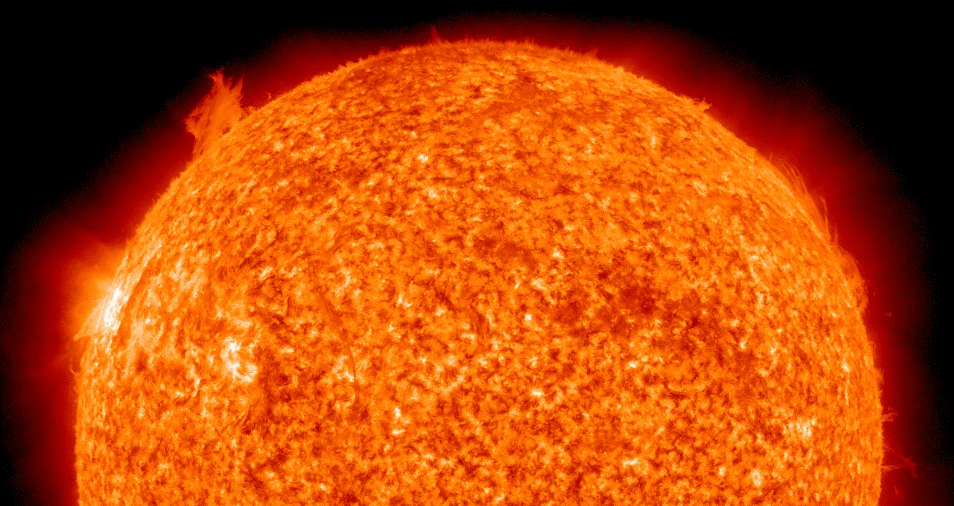Spaceweather.com and NASA reported :
GLOBAL ERUPTION: This morning (September 22, 2010) between 0230 UT and 0600 UT, the northern hemisphere of the sun erupted in a tumult of activity. At least two dark magnetic filaments became unstable and lifted off the stellar surface, a B8-class solar flare flashed from sunspot 1109, and a bright coronal mass ejection billowed into space. Click on the image to play a time-lapse movie from Solar Dynamics Observatory–and pay attention to the circled regions:
Coronal Mass Ejection on September 22, 2012
The eruption is reminiscent of the global event of August 1st, which hurled a CME toward Earth and sparked Northern Lights in the United States as far south as Iowa. This time, however, the CME will miss Earth so there should be no resulting geostorms.
52 days after previous eruption
This eruption happened 52 days after the previous eruption. This is what we wrote on the blog published on Thursday, August 12th (written a week earlier): The only way to get a better grasp on what is happening is to study the sun more closely. If we do not get to witness another complex eruption on the sun anywhere between August 6 and the end of September 2010, chances are high that the cycle counts 87 days. Let’s see what reality brings!
This eruption disrupts the repeating pattern of 87.5 days…. So October 27 is not sure…
Relation with declining field strength of sunspots
Scientists studying sunspots for the past 2 decades have concluded that the magnetic field that triggers their formation has been steadily declining. If the current trend continues, by 2016 the sun’s face may become spotless. Sunspots appear when upwellings of the sun’s magnetic field trap ionized plasma—or electrically charged, superheated gas—on the surface. Normally, the gas would release its heat and sink back below the surface, but the magnetic field inhibits this process. From Earth, the relatively cool surface gas looks like a dark blemish on the sun.
The last solar minimum should have ended last year, but something peculiar has been happening. Although solar minimums normally last about 16 months, the current one has stretched over 26 months—the longest in a century. One reason, according to a paper to the International Astronomical Union Symposium No. 273, an online colloquium, is that the magnetic field strength of sunspots appears to be waning.
Since 1990, solar astronomers Matthew Penn and William Livingston of the National Solar Observatory in Tucson, Arizona, have been studying the magnetic strength of sunspots using a measurement called Zeeman splitting. Named after the Dutch physicist who discovered it, the splitting is the distance that appears between a pair of lines in a spectrograph of the light given off by iron atoms in the sun’s atmosphere. The wider the splitting, the greater the intensity of the magnetic field that created it. After examining the Zeeman splitting of 1500 sunspots, Penn and Livingston conclude that the average magnetic field strength of sunspots has declined from about 2700 gauss—the average strength of Earth’s field is less than 1 gauss—to about 2000 gauss. The reasons for the decrease are not clearly understood, but if the trend continues, sunspot field strength will drop to 1500 gauss by as early as 2016. Because 1500 gauss is the minimum required to produce sunspots, Livingston says, at that level they would no longer be possible. But Livingston cautions that the zero-sunspot prediction could be premature. “It may not happen,” he says. “Only the passage of time will tell whether the solar cycle will pick up.” Still, he adds, there’s no doubt that sunspots “are not very healthy right now.” Instead of the robust spots surrounded by halolike zones called penumbrae, as seen during the last solar maximum, most of the current crop looks “rather peaked,” with few or no penumbrae.
Conclusions:
1. Global eruptions seem to be a new reality
2. They are related to the sunspot cycle and the weakening of the magnetic field strength of the sunspots
3. Will there be another eruption on October 27? Chances are diminishing… Bu we follow up on a daily basis…
4. The field strength of the sunspots will be so low at the end of 2012… that they can easily reverse… In other words a dramatic switch in the magnetic field of the sun…. This will create thousands of sunspots resulting in a ‘Killer Flare’. It is this Flare that will destroy our civilisation in 2012…
WATCH THIS VIDEO:
Click here to view the embedded video.

No comments:
Post a Comment